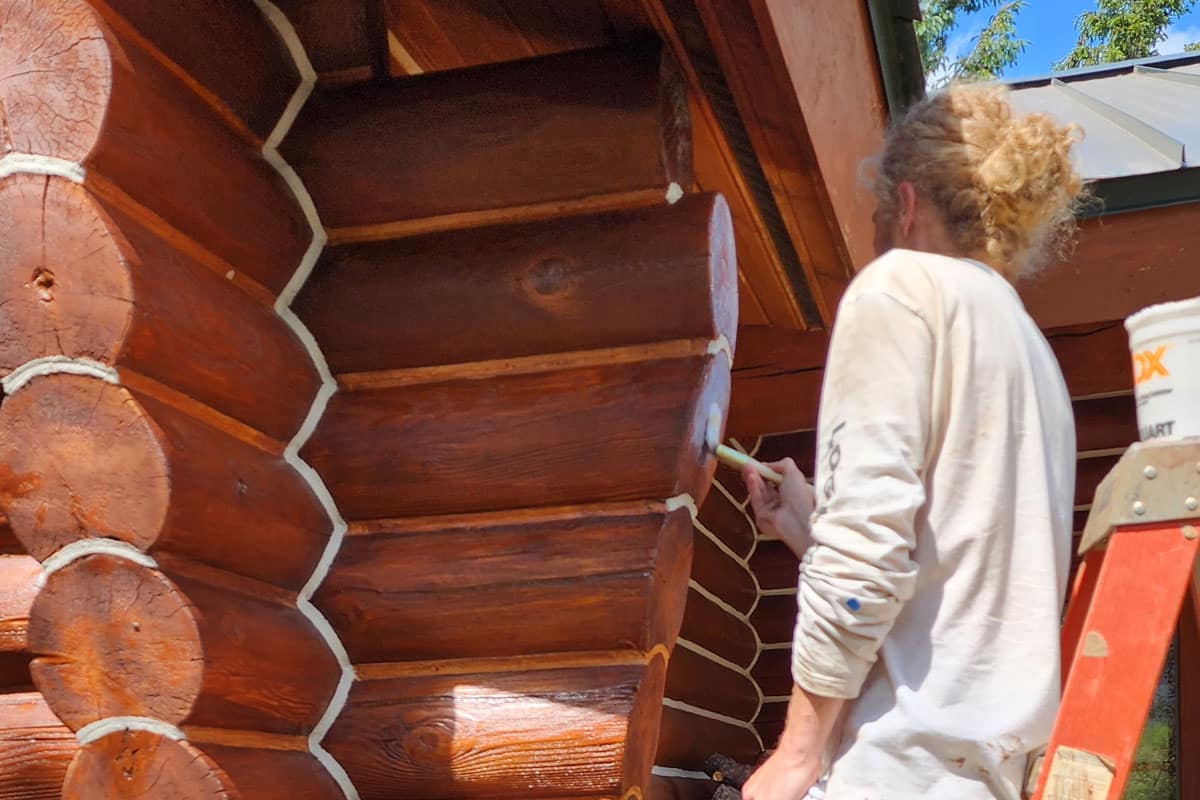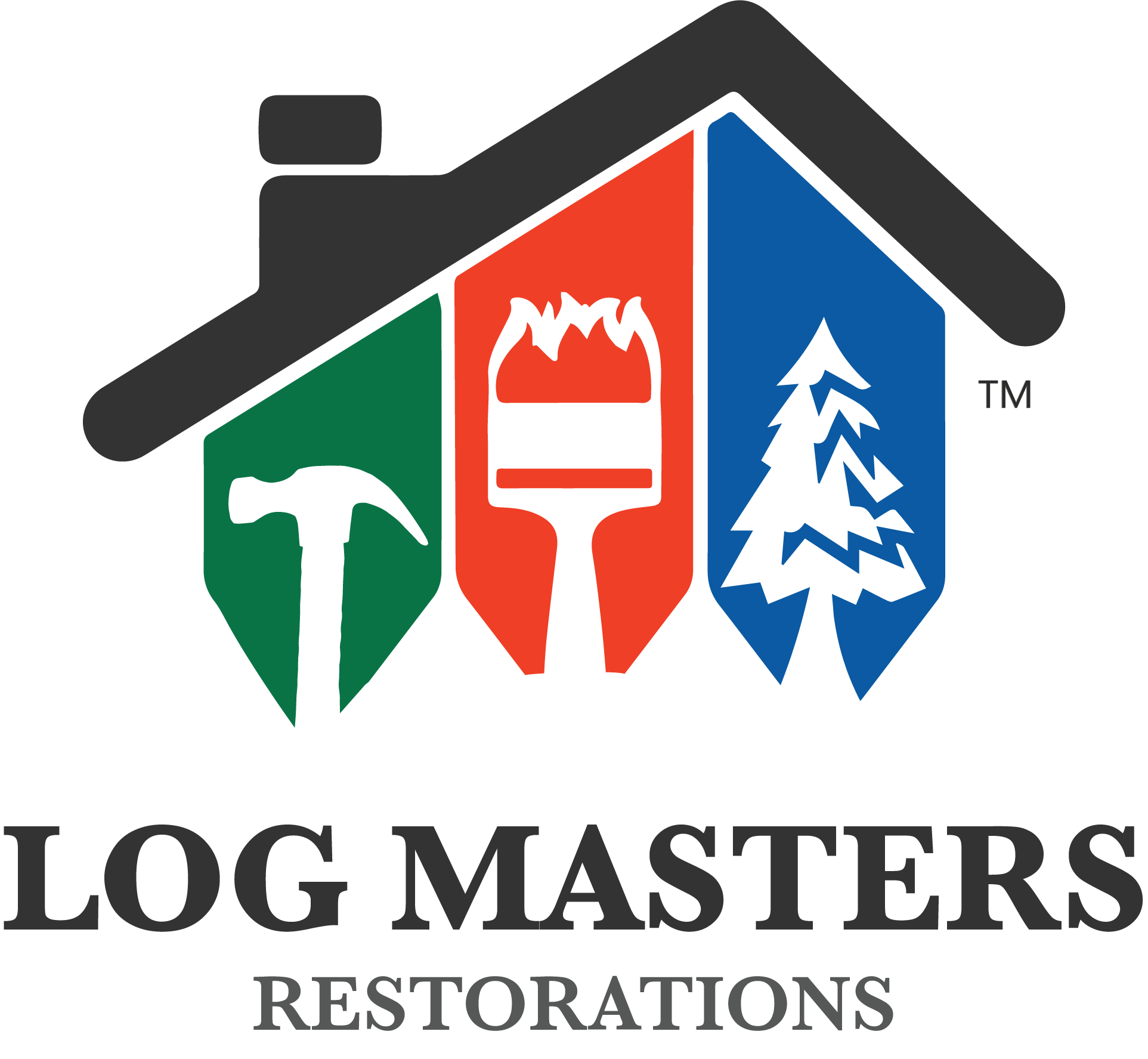Has your log home lost some of its charm? Your timber haven requires more than occasional cleaning and checkups—it might need a fresh coat of stain.
Whether you are a new log homeowner or you’ve been in your cabin for decades, Log Masters Restorations is here to help you look for the signs that it’s time to re-stain your log home.
What is Log Cabin Staining?
Log cabin staining applies a protective coating to the wood surface. This “armor” shields your home from environmental and biological damage. Stains protect against UV rays, water damage, insects, and fungi. Staining can also increase the visual appeal of your cabin, as the stain penetrates wood fibers, enhancing resistance and making grain patterns more vibrant.
There are many styles and colors of log staining to choose from. You can select from clear stains that highlight the natural beauty of the wood, semi-transparent stains that add a touch of color while still showcasing the grain, or solid-color stains that provide a more uniform burst of color to its appearance.
Each style offers unique benefits, allowing you to tailor the look and protection level to your preferences. Staining can transform the aesthetic of your log home while ensuring it remains well-protected.

Why Re-Staining is Crucial for Log Home Longevity
Re-staining a log home may be a challenge during your busy everyday life. However, regular staining for a log cabin is crucial. Your lovely wooden retreat requires regular maintenance to stand beautifully in the face of nature’s tests.
Preserving Authenticity through Stains
Re-staining does more than touch up your log home; it sustains its authenticity and longevity. High-quality stains conceal imperfections and highlight the striking features of the wood grain. They also protect against destructive insects, harmful UV rays, and harsh weather elements, significantly preventing decay.
The vibrant color the stain adds enhances your home’s rustic charm, ensuring it remains a beautiful and durable haven. Regular re-staining is essential for maintaining your log home’s aesthetic and structural integrity.
Understanding Stain Lifespan
Different finishes on logs have varying lifespans. Water repellents last 6-12 months, offering short-term protection. Clear water repellents extend this period to 1-2 years, balancing protection and natural aesthetics. Pigmented stains and varnishes typically last 2-3 years, providing moderate durability and color enhancement.
Solid-color stains demonstrate superior longevity, lasting 3-7 years, making them cost-effective. Semi-transparent stains, favored for their balance of protection and beauty, can last 3-8 years. Understanding these lifespans helps you plan when to re-stain your log home effectively.
8 Signs It’s Time to Re-Stain Your Log Home
Understanding the lifespan of your log home’s stain helps you plan maintenance schedules. However, there are vital signs indicating an immediate need for restaining. Here are the most common signs it’s time to re-stain your cabin:
1. Loss of Sheen: Identifying a Flat Finish
Start by closely observing the sheen of your log home. Staining adds a glossy aesthetic and protective layer. If the glossy finish has dulled to a flat, lackluster appearance, it’s a sign that your stain may need refreshing. This change suggests that the protective properties of the stain are diminishing, leaving your logs more vulnerable to weathering and decay. Keeping an eye on the sheen can help you catch potential issues early and maintain your home’s beauty and durability.
2. Color Shifts in Log Stain
Notice subtle yet significant changes in stain color over time. Sunlight exposure can cause fading or undesirable shifts in the wood’s color. These changes signal the need to reassess your log home’s stain condition. Regular inspection of the color ensures timely maintenance to preserve your home’s aesthetic appeal and protective qualities against weathering.
3. Water Test: Assessing Water Shedding
Conduct a water test to gauge the effectiveness of your stain. Observe how water droplets behave: they should bead up and roll off if the stain is still protective. Absorption into the wood indicates the need for re-staining to maintain protection against moisture damage.
This test is a quick and reliable method of determining whether your log home is due for maintenance. Regularly performing this assessment helps you stay proactive in preserving your cherished log home’s beauty and structural integrity.
4. Surface Contaminants: Dirt, Pollen, and Bird Droppings
Observe for grimy buildup and organic matter, such as bird droppings, on your logs. Staining should resist these contaminants. Difficulty removing them suggests the protective stain is old and needs attention. Addressing these issues ensures your log home remains aesthetically pleasing and well-protected against environmental elements.
5. New Micro Cracks in The Wood
An adequately stained surface typically prevents cracking or peeling from weather exposure. However, new micro checks and minor splits in the wood indicate that the stain may need immediate reapplication. These small splits can expand without prompt attention, leading to more noticeable damage and compromising the wood’s integrity. Regularly inspecting the wood for these signs is crucial to maintaining its durability and aesthetic appeal.
6. Fading Beauty: When Aesthetics Indicate Protection Loss
The aesthetics of your logs can reveal much about the underlying condition of the stain. If your once stunning log home now looks less architecturally appealing, it’s a clear sign that the protective stain is wearing off. This visual decline should motivate you to take immediate preservation actions. Ignoring these indicators can cause more severe issues, compromising your log home’s structural integrity and longevity.
7. The Tape Test: Diagnosing Previous Stain Layers
The tape test effectively diagnoses whether previous stain layers still protect the wood. To perform this test, apply a strip of tape to your logs and then peel it off. If flaky remnants stick to the tape, it’s clear evidence that your log home needs restaining. This simple method provides a quick assessment of your stain’s condition.
8. Weather Exposure: The Effects of Sun, Rain, and Wind
Exposure to the elements is inevitable for any log home. However, this constant battering from nature can take a toll on your log cabin’s stain, leading to its deterioration over time. Sun exposure significantly impacts your log home’s stain. Prolonged contact with sunlight causes your log cabin to lose its lustrous sheen and fade into a dull finish. Ultraviolet (UV) rays are particularly damaging, continuously degrading the stain bit by bit.
Rainfall adds another layer of concern. Log homes exposed constantly to rain may show signs of water absorption in their wooden surfaces. These signs indicate compromised sealant integrity and necessitate immediate attention. Water damage affects aesthetics and weakens the wood structure over time.
Strong winds bring dirt particles and other microscopic debris that become ingrained into your log’s surface. This debris makes the coating look visibly dirty and old while progressively eroding. The combination of dirt and wind abrasion accelerates the stain’s wear and tear, reducing its protective capabilities.
Professional Assessment: When to Call the Experts
Do you need help determining whether to seek expert opinions on re-staining your log home? Here are some tips on the importance of professional help and when to call the experts!
Why Expert Assessment Matters
Professionals have years of experience and technical knowledge. They notice subtle cues that untrained eyes miss, such as shifts in color or early-stage micro checks. These details, seemingly trivial to many, are significant warning signs for professionals. Expert assessments ensure no detail goes unnoticed, preserving your home’s longevity.
When to Call the Experts
Vigilant homeowners can identify signs of needed log home re-staining, but professional assessments are invaluable. Experts provide a thorough checkup for your home, just like a health examination. You should call experts at least once a year for an inspection and every 2-3 years for a comprehensive evaluation. Knowing when to call log home experts is crucial for preserving your log home’s staining.
Cost and Time Considerations
Cost is a significant factor in deciding to call an expert. Professional staining may cost less than extensive repairs due to neglected maintenance. Consistent professional care saves you time and effort, which is vital for busy homeowners. Regular inspections and external washes, recommended annually, help catch potential issues early.
Maintaining Your Log Home’s Beauty and Protection with Log Masters Restorations
Log home staining is crucial for maintaining your home’s beauty and structural integrity. At Log Masters Restorations, we specialize in keeping your log haven stunning while protecting its value for the long run. Our expert team understands that staining your log home isn’t just about looks; it’s about providing a robust shield against elements like moisture, UV rays, insects, and age-related wear.
We conduct a thorough examination to determine the best staining approach, using high-quality stains from top suppliers. Our process includes diagnosing existing stain types, removing previous layers if necessary, and applying a fresh coat that enhances and protects. We ensure every detail is perfect, from power washing to final sealing, providing a long-lasting finish. Contact us today to keep your log home beautiful and well-protected with Log Masters Restorations!
